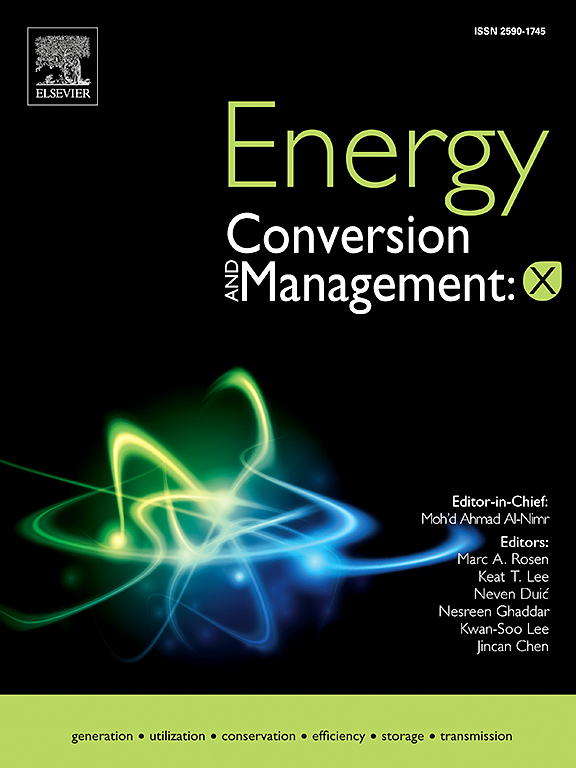不确定条件下的区域能源系统优化:来自美国华盛顿特区案例研究的见解
IF 9.9
1区 工程技术
Q1 ENERGY & FUELS
引用次数: 0
摘要
本研究调查了为棕地提供经济实惠的供暖和制冷的解决方案,重点研究了华盛顿特区的一个案例。朝着更加多样化和弹性的能源系统发展,我们确定了具有多样化能源的区域能源系统的最佳组合,以满足该地区的能源需求。我们的方法方法集成了两个详细的模型:一个计算建筑层面的能源需求,另一个根据需求概况优化区域能源技术选择,考虑能源价格、政策和其他参数的不确定性。结果在建筑层面提供了区域和个人供应选择的经济比较,强调了区域系统可以为电力部门提供的灵活性。在能源价格波动和外部不确定性的情况下,区域能源系统显示出成本稳定效益。在供暖方面,由于燃料的灵活性和当地可再生能源的使用,与单独的解决方案相比,区域系统可以节省大量成本。在冷却方面,区域系统也显示出优势,尽管单个系统对于较小的建筑物可能仍然更具成本效益。此外,区域系统在供热方面表现出相当大的灵活性,电力消耗的变化证明了这一点。我们建议未来的研究探索区域能源系统的经济性之间的关系,特别是在建筑层面,以及它们在不同地理环境下电力部门的灵活性潜力,以降低总体电网成本并提高电网可靠性。这包括具有不同分区法律、市政优先事项、公用事业结构和融资机制的地区,如美国,以及电价明显波动的地区,如欧洲。本文章由计算机程序翻译,如有差异,请以英文原文为准。
Optimizing district energy systems under uncertainty: Insights from a case study from Washington D.C., USA
This study investigates solutions for delivering affordable heating and cooling to a brownfield site, focusing on a case study in Washington, DC. Moving towards more diverse and resilient energy systems, we identify the optimal portfolio for a district energy system with diverse energy sources to meet the area’s energy demands. Our methodological approach integrates two detailed models: one calculating building-level energy demand and the other optimizing district energy technology choices based on their demand profiles, accounting for uncertainties in energy prices, policies, and other parameters. The results provide an economic comparison of district and individual supply options at the building level, emphasizing the flexibility district systems can offer to the electricity sector. District energy systems demonstrate cost-stabilization benefits amidst volatile energy prices and external uncertainties. For heating, district systems yield significant cost savings compared to individual solutions, driven by fuel flexibility and the use of local renewable energy sources. For cooling, district systems also show advantages, though individual systems may remain more cost-effective for smaller buildings. Additionally, district systems exhibit considerable flexibility on the heating side, as evidenced by variations in electricity consumption. We recommend future research to explore the relationship between the economics of district energy systems, particularly at the building level, and their flexibility potential for the electricity sector across diverse geographic contexts to reduce overall grid costs and promote grid reliability. This includes areas with distinct zoning laws, municipal priorities, utility structures, and funding mechanisms, such as the United States, and regions like Europe with pronounced electricity price volatility.
求助全文
通过发布文献求助,成功后即可免费获取论文全文。
去求助
来源期刊

Energy Conversion and Management
工程技术-力学
CiteScore
19.00
自引率
11.50%
发文量
1304
审稿时长
17 days
期刊介绍:
The journal Energy Conversion and Management provides a forum for publishing original contributions and comprehensive technical review articles of interdisciplinary and original research on all important energy topics.
The topics considered include energy generation, utilization, conversion, storage, transmission, conservation, management and sustainability. These topics typically involve various types of energy such as mechanical, thermal, nuclear, chemical, electromagnetic, magnetic and electric. These energy types cover all known energy resources, including renewable resources (e.g., solar, bio, hydro, wind, geothermal and ocean energy), fossil fuels and nuclear resources.
 求助内容:
求助内容: 应助结果提醒方式:
应助结果提醒方式:


